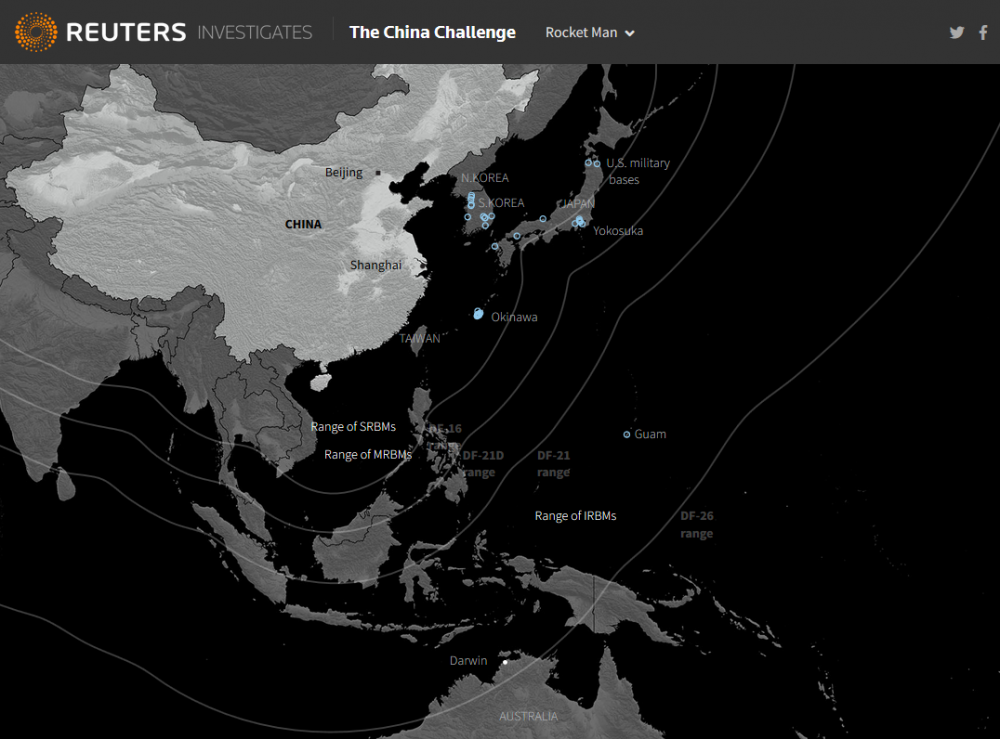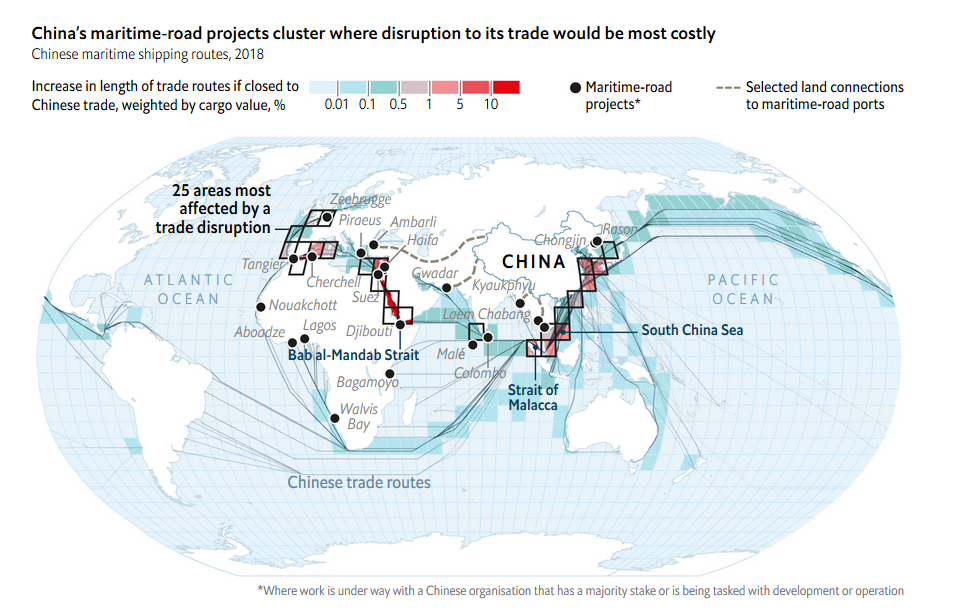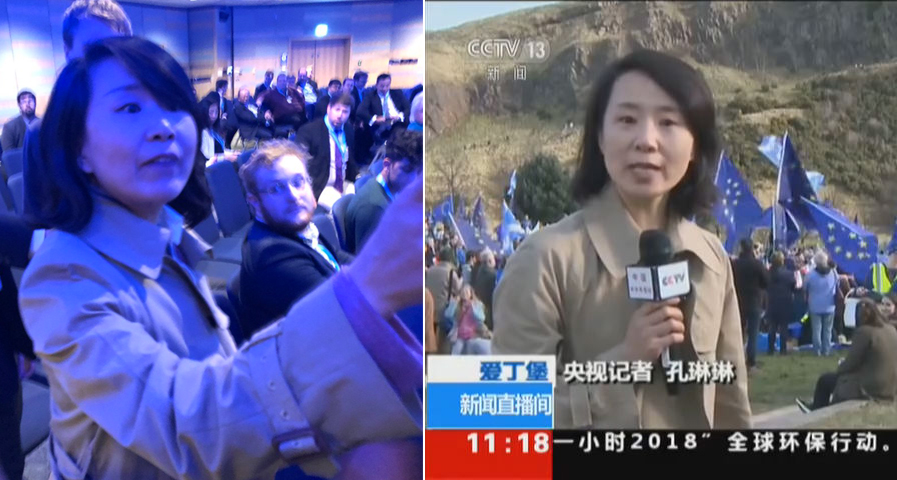笨狼发牢骚
发发牢骚,解解闷,消消愁
正文
战略与国际研究中心(Center for Strategic and International Studies,简称CSIS)一位研究员(公号@GregPoling)最近参加了该机构太平洋诸事专家论坛,他提到除他外所有专家都一致否认南海诸岛有任何军事价值,他持异议,发表了一大堆意见,太长了,我把它附录在下。
原处还有很多其他专家个人的意见,我也瞎说几句。
南海诸岛的价值主要是地缘政治上的。
第一,南海诸岛的军事战略价值是有限的。在两国真正发生冲突时,南海诸岛不足以成为一个能坚守的军事基地。然而战争不是那么简单的,如果南海诸岛守不住,那关岛也守不住,夏威夷才行,因为夏威夷才足够大,这是因为现代战争的威力太大。

中国各种导弹威慑区域【4】
第二,南海诸岛有关键性的战术价值。万一在台湾或钓鱼岛发生冲突,美国必须摧毁对南海诸岛的威胁,这大概会为中国赢得一个星期的时间。
第三,这些都不是关键的。关键的是它们的地缘政治价值。没有南海诸岛,九段线就形如空话,这点必须从历史的角度来看。17、18世纪英法殖民的时候,就是派几艘军舰巡游全世界,看到一个好地方,就插上一面国企,关键的,是返航后公布一份地图,这结果是口头公布我们把这占了。
这看上去没什么用,但这正是地缘政治的手段:看看你们谁敢跟我大英帝国或法兰西共和国抢,如果那块地很重要,或者对手不太强,以后都可以斟酌是否采取大局军事干预的策略。
这一手段现在使用起来不那么有用,中国既需要建立这么一个既成事实,但又必须克制,而不至于把美国逼到无可后退的程度,导致两国发生军事冲突。过去六七年的历史证明中国极其高超。
对中国来说,与美国进入军事冲突,甚至只是军事对抗,都是致命的后果,因为中国需要大量的原材料,不论是你死我活还是僵持的对峙中国都必败,但恰如我以前说过的【1,2】,美国也会打败,是人类末日,所以不仅中国担心,美国也担心,只是双方这种玩火的行径很危险【3】。
这就说到一带一路的目的,有人说这是为了输出过剩产能,有这个意思,有人说是控制发展中国家的劳工和消费市场,也挂个边,最关键的,是要把全世界不用军事,而用经济的手段拉到自己一边。这种非军事的“共同体”不仅针对美国,更是扬长避短,而且在其他国家中有说服力,口号“过好日子”,这是为什么那么多国家参与的原因。
至于多少国家只是搭顺风车是无关紧要的,因为要“双赢”,就得允许他人赚便宜,那样至少在经济利益上他们会站在你的一边,当然中国的口号是“高调是假,好日子才真”,落后国家都觉得可信。近来习近平高调出席国际进口博览会,吹嘘双十一【6】,大肆宣传中国消费市场,中央最近搞好进口、开放市场的新政策【7】,都是为了这一目的。

这个跨越全球的网络好像是要征服世界,《经济学人》【5】把所有据点列出来,就觉得那只是个“防线”,而不是进攻:

麻省理工的M. Taylor Fravel对此有专注,他觉得中国的防御策略是作适当战略性进攻,进而是为了更好的防守,简单化叫战略纵深(但已经国际化了),所以中国本质上是不具威胁的。

所以一带一路的核心目的是当你把你的产业网,而不是某个产业链,连到你的经济共同体内之后,美国如果进攻,切断你的供给,也就是侵略了共同体其它成员的利益,这才是要害。
【参见】
知道这多难,见明年(2020)中国总产值是多少?。习近平的大国外交【8】很多迹象都显示出过度冒进,在西方引起越来越激烈的反感(如【9】),连中国人民老朋友默克尔也几乎站不住了,威胁到华为的前途。

连记者也成了卒子:

【资料】
【3】世界大战是如何打起来的?
THREAD > Someone please prove me wrong. During today's CSIS conference on the ECS, SCS, and Pacific Islands I emerged as the clear contrarian on one point: I don't buy the argument that China's artificial islands are useless in a war or would be easy for US forces to neutralize.
First, they're enormous. As I recall @tshugart3 once pointed out, Mischief Reef is about the size of the 495 beltway around DC. Pearl Harbor Naval Base could fit in the lagoon at Subi Reef. That's a lot of ordinance to drop.
We also have to assume that a not insignificant number of missiles any adversary launched at the islands wouldn't make it through the various defenses. I believe @tshugart3 also once did a simulation to this effect based on US experience hitting Shayrat Airbase in Syria.
And as in that case, a strike would likely only disable the airstrips for a short time, unless, that is, you dropped A LOT of ordnance. So where's that ordnance coming from?
Well IF China is first mover in this hypothetical conflict it will presumably have already deployed combat aircraft to the airbases on the artificial islands. Barring a sudden rapid implementation of EDCA this means China will have air dominance.
The only ground-based US aircraft in the region will be 497th Combat Training Squadron in Singapore and a small number of patrol aircraft in Malaysia & PH. Combat aircraft are 1300nm away in Okinawa or 1500nm away in Guam.
If the US happens to have a carrier in the SCS when hostilities erupt, it'll be well within the range of ballistic missiles from the mainland as missiles from the islands (& Chinese subs?). 1st priority will be steaming east as fast as possible all the way to the Philippine Sea
In the face of both the missile threat and Chinese air dominance, every other US Navy ship will likely be heading east too as fast as possible. So that only leaves US submarines in the theater.
US subs could probably continue to operate without detection. But that'll be a lot harder if they start shooting. And if they're going to do that, Chinese surface ships are much more valuable and viable targets than trying to blanket a DC-sized Air Base at Mischief Reef.
Subs launching an attack on the bases would have to do so at risk of exposure to Chinese ASW capabilities (e.g. ships/subs as well as the ASW helibase at Duncan Island if they're trying to hit Woody Island in Paracels too).
So that leaves long-range bombers from Guam. But that would be putting very high value assets at risk in a secondary theater. Secondary because I can't imagine a scenario in which the US would drop bombs on bases in the Spratlys that wouldn't also mean a war in Northeast Asia.
So in that conflict where does neutralizing the Spratlys fall in the order of US priorities? Far below defense of Japan and US forces there, as well as potentially Taiwan depending on the scenario.
So yes, the US technically has the capability to neutralize Chinese bases in the Spratlys. And given logistical and maintenance problems China likely can't operate combat aircraft from the islands for very long.
But for the opening stages of any hypothetical conflict, based on current US posture in the region, the islands give China air dominance, help force US surface ships out of the SCS, and could only be neutralized at a cost US couldn't afford given needs in Northeast Asia.
This could of course be changed with a rapid and full implementation of EDCA, allowing US rotational combat aircraft in PH, combined with positioning US missiles/artillery in PH to hold Chinese islands and ships at risk. But no signs of that happening yet (or under Duterte)
All of that said, I'm neither a war planner nor a naval operator. So what am I missing?
评论
目前还没有任何评论
登录后才可评论.




